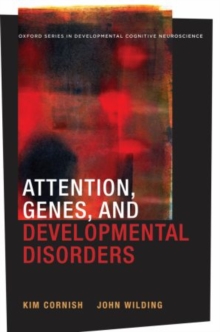
Neurodevelopmental Disorders Across the Lifespan : A neuroconstructivist approach EPUB
Edited by Emily K. Farran, Annette Karmiloff-Smith
Part of the Developmental Cognitive Neuroscience series
EPUB
Description
Nowadays, it is widely accepted that there is no single influence (be it nature or nurture) on cognitive development.
Cognitive abilities emerge as a result of interactions between gene expression, cortical and subcortical brain networks, and environmental influences.
In recent years, our study of neurodevelopmental disorders has provided much valuable information on how genes, brain development, behaviour, and environment interact to influence development frominfancy to adulthood. This is the first book to present evidence on development across the lifespan across these multiple levels of description (genetic, brain, cognitive, environmental).
In the book, the authors have chosen a well-defined disorder, Williams syndrome (WS), to explore the impact of genes, brain development, behaviour, as well as the individual's environment on development.
WS is used as a model disorder to demonstrate the authors approach to understanding development, whilst being presented incomparison to other neurodevelopmental disorders - Autism, Developmental Dyscalculia, Down syndrome, Dyslexia, Fragile X syndrome, Prader-Willi syndrome, Specific Language Impairment, Turner syndrome - to illustrate differences in development across neurodevelopmental disorders. Williams syndrome is particularly informative for exploring development: Firstly, it has been extensively researched at multiple levels: genes, brain, cognition and behaviour, as well as in terms of the difficulties of daily living and social interaction.
Secondly, it has been studied across the lifespan, with many studies on infants and toddlers with WS as well as a large number on children, adolescents and adults.
The authors also explore a number of domain-general and domain-specificprocesses in the verbal, non-verbal and social domains, across numerous neurodevelopmental disorders.
This illustrates, among other factors, the importance of developmental timing, i.e. that the development of a cognitive skill at a specific timepoint can impact on subsequent development within that domain,but also across domains.
In addition, the authors discuss the value of investigating basic-level abilities from as close to the infant start-state as possible, presenting evidence of where cross-syndrome comparisons have shed light on the cascading impacts of subtle similarities and discrepancies in early delay or deviance, on subsequent development. Designed such that readers with an interest in any neurodevelopmental disorder can gain insight into the intricate dynamics of cognitive development, the book covers both theoretical issues and those of clinical relevance.
It will be an invaluable reference for any researcher, clinician, student as well as interested parents or teachers wishing to learn about neurodevelopmental disorders from a developmental framework.
Information
-
Download - Immediately Available
- Format:EPUB
- Publisher:OUP Oxford
- Publication Date:15/12/2011
- Category:
- ISBN:9780191625626
Information
-
Download - Immediately Available
- Format:EPUB
- Publisher:OUP Oxford
- Publication Date:15/12/2011
- Category:
- ISBN:9780191625626










